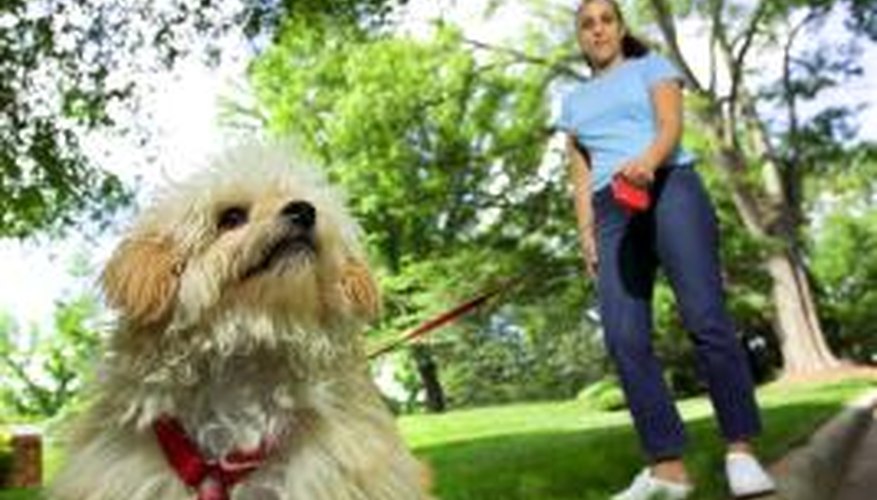A training collar connects your dog to his leash so that you can walk alongside him with some degree of control. Use a training collar to teach your dog how to walk obediently while wearing a leash. While training collars are available in several forms, including premier collars, prong collars, choke collars, shock collars and different types of harnesses.
Function
A harness' function varies according to the size of your dog. Some smalls dogs wear harnesses for medical reasons, like a sensitive trachea or respiratory illnesses. Large dogs tend to be stronger and owners rely on harnesses to increase control over their dogs. Harnesses suit dogs possessing wide necks and smaller heads that slip out of traditional collars worn over the neck.
- A harness' function varies according to the size of your dog.
- Some smalls dogs wear harnesses for medical reasons, like a sensitive trachea or respiratory illnesses.
Body Harness
A traditional body harness connects your dog's leash at the shoulder blades.
Harnesses fit smaller breeds, like Yorkshire Terriers and Shi Tzus, who do not fit regular dog collars that wrap around a dog's neck. Harnesses also benefit dogs that resist pulling on the leash. When worn all day, harnesses can chafe your dog's armpits. Furthermore, dogs who have long hair can suffer from matting when wearing harnesses for long periods of time. Because harnesses distribute a dog's strength more uniformly, dogs are also more prone to pulling the leash. Excessive pulling can damage a dog's trachea.
- A traditional body harness connects your dog's leash at the shoulder blades.
- Harnesses fit smaller breeds, like Yorkshire Terriers and Shi Tzus, who do not fit regular dog collars that wrap around a dog's neck.
No-Pull Harness
Unlike traditional harnesses, no-pull harnesses connect your dog's leash at a small hook placed over a chest strap. When your dog races ahead of you during walks, a no-pull harness will guide him back to you, preventing pulling. These harnesses suit larger dogs and dogs who constantly tug at the leash. No-pull harnesses increase your dog's risk of chafing at the armpits where skin is sensitive. For this reason, they are not suitable for use during long periods of time. Similarly, long hair will become matted when long haired dogs wear no-pull harnesses for extended periods. They are also more expensive than other harnesses.
- Unlike traditional harnesses, no-pull harnesses connect your dog's leash at a small hook placed over a chest strap.
- Similarly, long hair will become matted when long haired dogs wear no-pull harnesses for extended periods.
Head Harness
The head harness gets its name from the way it connects your dog's leash to his jaw. Head harnesses suit dogs who constantly pull their leashes. Similar to a horse harness, this harness discourages pulling because it guides the dog from its head. Because it discourages pulling, a head harness actually helps you train your dog to heel. While it does resemble a muzzle, a head harness is comfortable for dogs to wear and provide ample room for him to drink and bark. Some dogs are initially resistant to wearing a head harness and may take a long time to become accustomed to it. Some dogs even refuse to cooperate while wearing a head harness, stiffening their necks in to keep pulling at the leash.
- The head harness gets its name from the way it connects your dog's leash to his jaw.
- While it does resemble a muzzle, a head harness is comfortable for dogs to wear and provide ample room for him to drink and bark.
